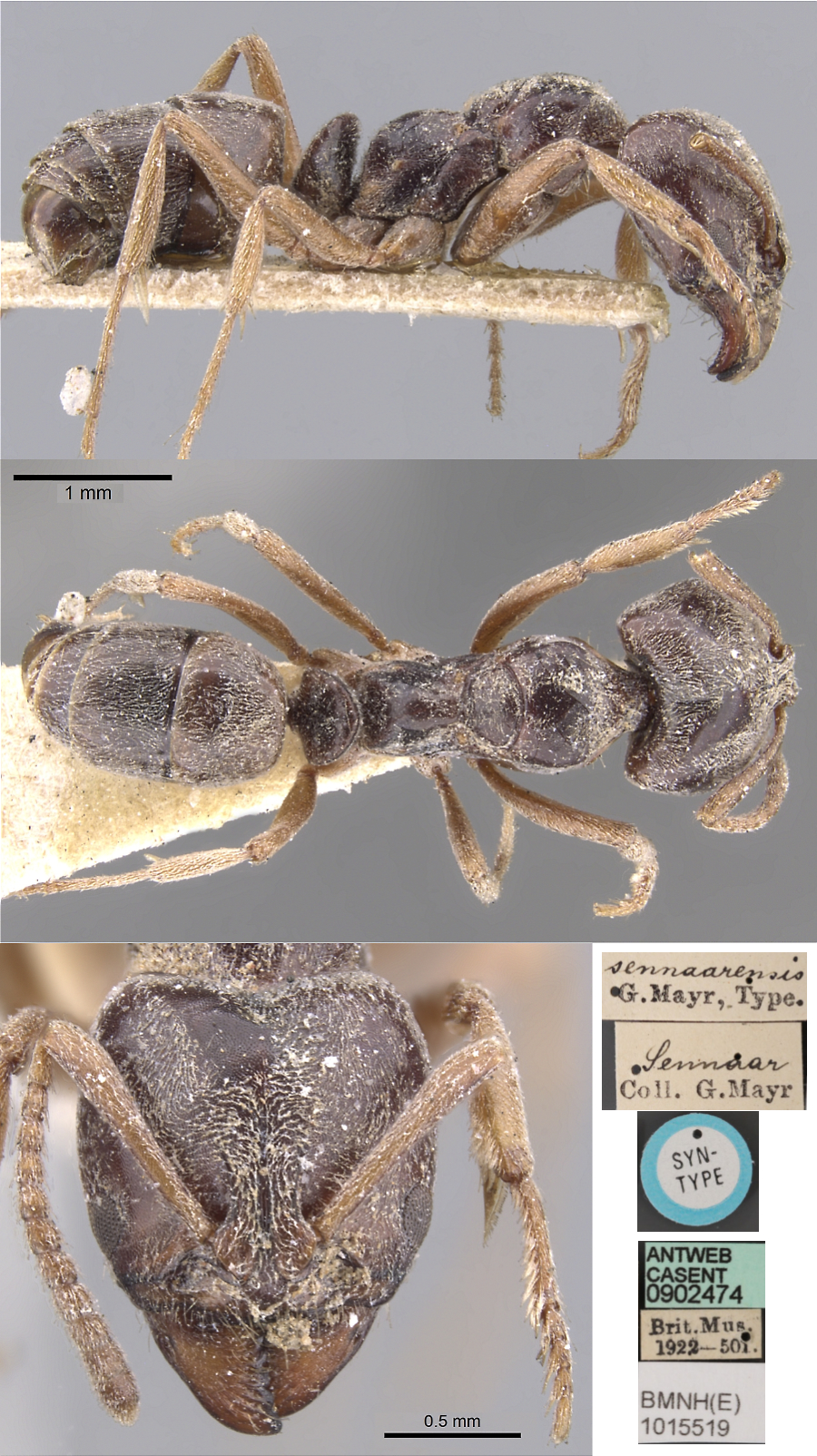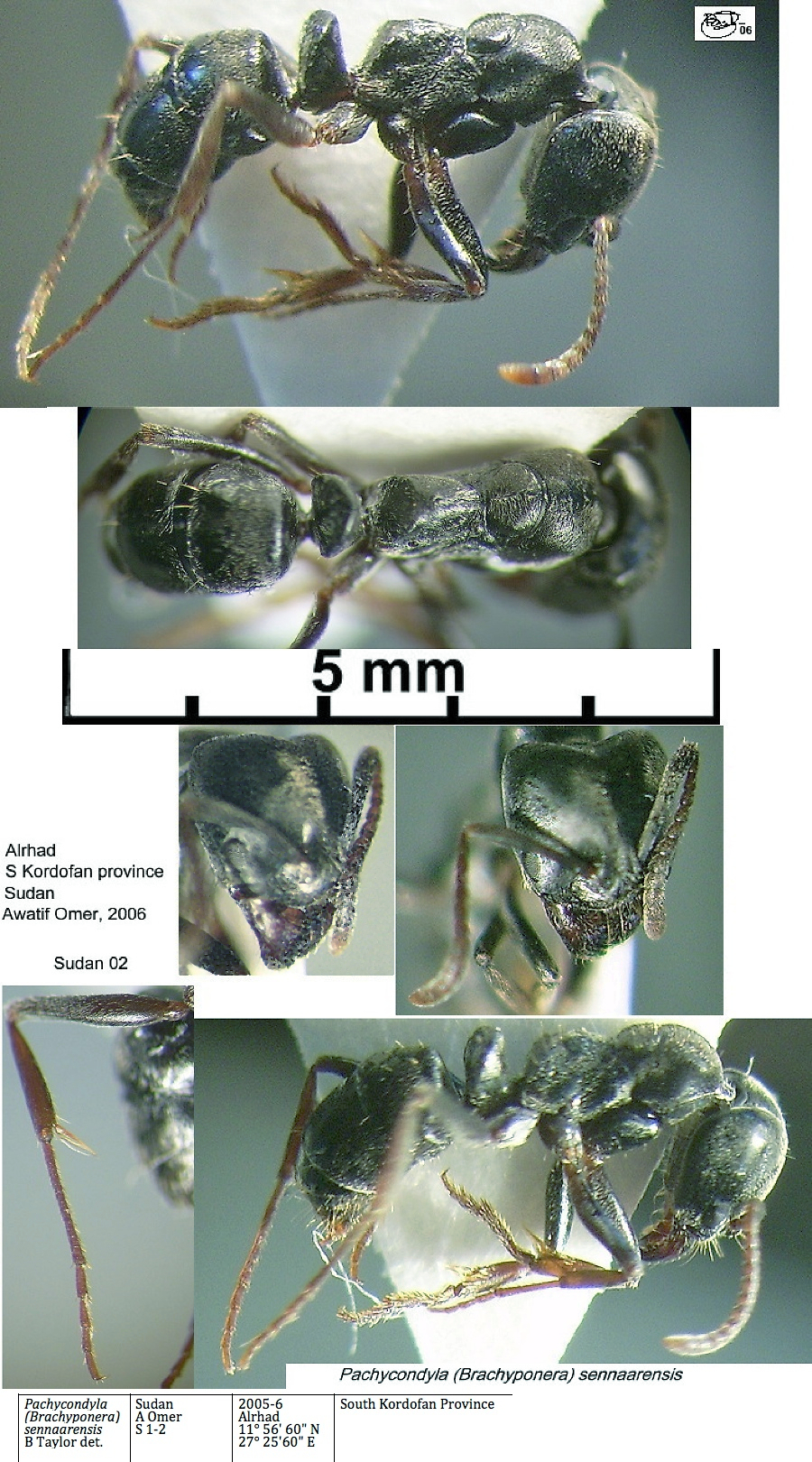Brachyponera sennaarensis (Mayr)
 Type location Sudan (Ponera
sennaarensis, Mayr, 1862: 721, worker; Santschi, 1910c: 350, queen
reported but not described; Forel, 1910c: 245, male reported but not
described; Pachycondyla sennaarensis
in André, 1890: 317; also in Collingwood, 1985: 241; genus revived by
Schmidt & Shattuck, 2014: 77) collected at Sennar - see below Type location Sudan (Ponera
sennaarensis, Mayr, 1862: 721, worker; Santschi, 1910c: 350, queen
reported but not described; Forel, 1910c: 245, male reported but not
described; Pachycondyla sennaarensis
in André, 1890: 317; also in Collingwood, 1985: 241; genus revived by
Schmidt & Shattuck, 2014: 77) collected at Sennar - see below
junior synonym sorghi (Ponera sorghi nov. sp., Roger,
1863a: 169, worker) from Sudan - no images on Antweb (November 2015)
all forms known.
Bolton (1995) had it in Pachycondyla Brown, new combination, but the
publication, 18 June, 2014, of:
Schmidt, C.A. & Shattuck, S.O. 2014. The Higher Classification of
the Ant Subfamily Ponerinae (Hymenoptera: Formicidae), with a Review of
Ponerine Ecology and Behavior. Zootaxa,
3817, 242 pp.
redressed the blanket lumping of genera and subgenera under Pachycondyla.
In general, I welcome their reclassification as redressing the post
Bolton/Brown situation, which was accepted without any argued
basis. The listing of species within the, largely, revived
genera, perhaps would be better based if Schmidt & Shattuck had
listed the species actually examined by them. Their species lists also
perhaps are confusing in listing subspecies but not synonyms. The lists
give type location countries but not modern distributions.
|
Mayr's (1862)
description is at  . Roger's (1863a) description of sorghi
is at . Roger's (1863a) description of sorghi
is at  . Arnold (1915: 72) gave
a translation, this is at . Arnold (1915: 72) gave
a translation, this is at  and, male & queen, and, male & queen,  . .
For a fuller coverage of this species see - http://antsofafrica.org - Brachyponera sennaarensis
|
 The
photomontage of a syntype worker is
collated
from http://www.antweb.org/specimen.do?name=casent0902474.
Specimen probably faded by age, as Mayr gave the original colour as
predominantly black. The
photomontage of a syntype worker is
collated
from http://www.antweb.org/specimen.do?name=casent0902474.
Specimen probably faded by age, as Mayr gave the original colour as
predominantly black.
|
Egypt records - under junior synonym sorghi
Roger - Donisthorpe (1942a), two males from Siwa & one from Maragi,
collector J Omer-Cooper.
|
 The photomontage is of workers collected in Sudan
by Awatif Omer, 2006, from Alrhad, South Kordofan province. The photomontage is of workers collected in Sudan
by Awatif Omer, 2006, from Alrhad, South Kordofan province.
Essentially a savannah species which penetrates
adjoining forest zone areas. Nests directly into insolated soil, and
forages on the soil surface. It was studied in some detail by Lévieux
and Diomande, at Ferkéssédougou, Ivory Coast (Lévieux and
Diomande, 1978). They described it as probably the most common ant in
the Sudan savannah regions being found from Senegal right
across sub-Saharan Africa to Somalia, and right up to the southern edge
of the Sahara Desert at Tillabery in Niger, north of Niamey and
alongside the Niger River. To the south they described its range as
being brutally halted by the massif of the ebony forest. Its success
was attributed to its granivorous diet. The nest opens on to the
surface with a circular apertures, each 3-5 mm in diameter, around
which is piled debris from the diet and nest excavations. Foraging
openings some 2-3 mm in diameter, and perhaps 10 per m², permit access
from underground galleries over a total area of up to 600 m².
Dejean & Lachaud (1994), who studied the species in
Zaïre, described it as unique among ponerines in being partially
seed-eating, this being an adaptation to the dry areas which constitute
its main habitat. In the wet season, and in wetter habitats, animal
prey are the principal diet. In woodland areas, interestingly, the
workers are noticeably smaller than those of savannah colonies. On
balance they describe it as having a typically omnivorous diet, using
every available food source, including fruit and higher animal remains
where available, such as in the vicinity of human habitations. They
listed earthworms, coleopteran larvae, lepidopteran larvae, termites
and ants as the main prey.
|
 The photomontage is of a worker collected in Saudi
Arabia by Mostafa Sharaf. Collingwood (1985, illustrated),
reporting it from Saudi Arabia, described it as a robust, dark
coloured species. He added that it is an
agressive species, distributed throughout the African tropics, with
Arabia probably its northern limit. It "feeds mainly on dead insects
but is also attracted to sugary sunstances and food waste". The photomontage is of a worker collected in Saudi
Arabia by Mostafa Sharaf. Collingwood (1985, illustrated),
reporting it from Saudi Arabia, described it as a robust, dark
coloured species. He added that it is an
agressive species, distributed throughout the African tropics, with
Arabia probably its northern limit. It "feeds mainly on dead insects
but is also attracted to sugary sunstances and food waste".
|
 The photomontage is of a worker collected in Qatar
by Mostafa Sharaf. The photomontage is of a worker collected in Qatar
by Mostafa Sharaf.
|
Oxford University Museum
specimens
Brachyponera sennaarensis
B Taylor det. |
Saudi Arabia
M Sharaf
|
26.iv.2006
Farasan Is.
16°42' N
42°11' E
|
alt. 9 m; Major
Farasan I., Red Sea; protectorate building
|
1
|
 |
Brachyponera sennaarensis
B Taylor det. |
Qatar
Mahmoud Saleh
|
2010
|
|
1
|
 |
|
|